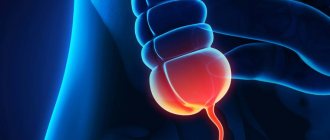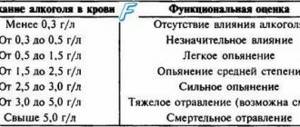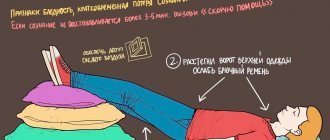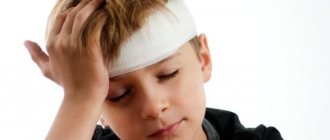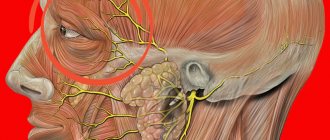What is disorientation?
In this process, the ability to think at an average speed disappears, the clarity and consistency of thoughts is significantly destroyed.
Signs of the disorder are problems with orientation in space and deterioration of attention. Logical thinking disappears and memory is degraded. The highest signs of the psyche change one by one. For example, only speech recognition may be affected. Memory problems are noted, spatial orientation is impaired. There are two types of confused consciousness, depending on the cause of its occurrence - fast and slow.
Manifestations can be one-time or permanent. Dementia and delirium are signs of the latter condition. The integrative function of thinking at the moment of confusion is absent. Along with the expected change, the patient is often silent, moves little, and is depressed outwardly. Illusions and hallucinations accompany the disease.
The first arise because the body incorrectly perceives the stimulus, while hallucinations manifest themselves independently. Each individual suffers from the disease differently - the determining factor is the root cause of the development of the disorder. Slowness of thinking and inconsistency of logical series are emphasized during the first minutes of conversation. Even non-professionals can notice the initial symptoms.
Psychotherapists divide delirium into several classifications: hallucinatory (the ability to see non-existent information); manic (obsession with aggression); catatonic (inability to fully move); confabulatory (twisting of an obvious fact).
It is classified as a mental disorder and can cause certain changes in the central nervous system. It is divided into short-term and long-term, depending on a number of factors. The patient is not able to describe himself as a person, there is no temporal and spatial orientation.
It should not be confused with childhood social disorientation, which is a temporary age-related process. The phenomenon is divided into two types: allopsychic, autopsychic. In the first case, there is an inability to determine location, as well as to separate time periods. In the second case, it is impossible to name the first name, last name, patronymic, date of birth, place of residence.
For diagnosis, the right questions are asked and clarity is established. If it is confused, an urgent consultation with a psychotherapist is necessary. For placement in a psychiatric hospital, the voluntary consent of the individual requiring medical assistance is required. Impaired consciousness makes it impossible to objectively assess the situation; hospitalization is carried out according to the estimated condition at the time of treatment. Direct relatives and family members can help expedite legal issues.
HIGH BP, DISORIENTATION IN SPACE
Michael
194 views
January 3, 2020
Male, 26 years old In childhood, there was a suspicion of glomerulonephritis, now kidney tests are almost normal. My constant blood pressure was 130-140, it remained this way all the time, but it didn’t interfere with life; I didn’t do anything about it. Around the middle of the summer of 2019, I began to feel some kind of loss, dizziness, difficulties with thinking, but I was not fully aware of this, I thought that it was all just my imagination. Over time, the symptoms gradually intensified and in mid-October an attack occurred and the sensations intensified, severe disorientation in space, it was difficult to think logically, severe dizziness, it was difficult to read and generally perceive any information, blood pressure rose to 180-190 units, an ambulance arrived, They gave me several injections, the pressure subsided, but the condition remained, but not so acute, I almost came to my senses. After this attack, I began to feel much worse in everyday life, the average pressure was 140-150 constant. But when I woke up I didn’t feel bad, after an hour or two the symptoms began to intensify. A local neurologist prescribed Neuroclin Neuroxone and Eglonil. My health has improved a little. A month passed and the pills stopped helping and things got worse. I did an MRI and this is the conclusion: a cyst of the septum pellucidum, without signs of disturbances in the cerebrospinal fluid dynamics. Map of single foci of vascular gliosis of the right frontal lobe. Signs of pituitary adenoma microadenoma. Prolactin was elevated twice as high as normal for a year and a half, but now it is normal, prolactin was not lowered in any way, it dropped on its own Creatinine 107 µmol/l Urea 4.8 mmol/l Protein per day 120 mg/24h Uric acid 417 µmol/l Had an ultrasound of the kidneys , hearts, thyroid glands, Doppler of the vessels of the neck, everything is normal X-ray of the neck is normal without curvatures Thyroid tests are normal Now I take co-prenesa 2.5/8 mg Nemotan 60 mg three times a day Adaptol 500 The condition is not getting better Constantly I feel like this: There is a pulsation in throughout the body There are dark spots in the eyes in time with the heartbeat and some kind of fireworks, glare Presses in the head It can be hard to breathe as if there is not enough air During attacks, the heartbeat increases, severe disorientation in space and a feeling that I’m going to lose consciousness, it’s hard to think, it’s hard to form thoughts, It's difficult to talk. Sometimes strong fear arises for no reason. Hell rises to 170-180 And problems with vision, it seems like I can see the picture and not see it at the same time, I don’t quite understand how to explain this correctly. Our doctors don’t know what diagnosis to give me, tell me, maybe there are some guesses about the diagnosis, maybe I can take some tests, undergo research, I’m ready for any manipulations and any prices. I’ve been visiting hospitals for three months now and getting nowhere. Everything I passed was normal, we don’t know where to dig. Thank you
Age:
26
Chronic diseases:
They put chronic diseases. Glomerulonephritis in childhood, but at the moment tests and studies are almost normal Chron. bronchitis
The question is closed
Why does disorientation and confusion occur?
A person in a state of disorientation is not able to realize his own personality, place of residence, time, social affiliation. Sometimes only one specific type of disorientation is noted, but in some cases a person exhibits a combination of the types of disorientation described above.
Early signs of confusion include disorientation and decreased attention. If this condition progresses, then the patient’s perception of the surrounding world and memory are gradually impaired, and later speech disorders occur. The patient does not recognize those who are next to him. Sometimes he has illusions - an incorrect perception of what is happening around him. As a rule, confusion leads to the fact that a person becomes silent, depressed, and moves very little.
Confusion in older people is characterized by a noticeable loss of orientation, confusion, and inability to act independently. Symptoms of confusion may appear gradually or suddenly. This syndrome can be either temporary (for example, patients periodically experience disorientation at night) or permanent.
Severe dizziness and confusion after anesthesia is a physiological phenomenon that disappears over time.
If confusion appears suddenly in a person and he/she experiences psychomotor hyperactivity and hallucinations, then the patient is diagnosed with delirium. Progressive and long-lasting confusion with gradual loss of a number of innate functions is defined as dementia.
General disorientation is also accompanied by autopsychic disorientation, which is characterized by various emotional disorders and disturbances in orientation in one’s personality.
Mental disorientation gradually leads to a noticeable change in a person’s personality. A person who has emotional and moral disorientation cannot distinguish between bad and good deeds, good and evil inflicted on other people. Symptoms of disorientation can be expressed by apathy, indifference to what is happening around.
Personal disorientation is manifested by a violation of orientation in a person’s consciousness and self-awareness. Disorientation in time periodically occurs - the patient does not understand what period of the day or day of the week it is, and is confused about what happened just now and earlier.
The causes of disorientation in space, time, self, confusion are serious symptoms indicating the development of diseases. Therefore, consulting a doctor in this case is necessary.
Social disorientation manifests itself due to various reasons associated with diseases and pathological conditions. In children, this syndrome may be associated with sudden changes in life, for example, with the start of kindergarten or school.
In young children, the manifestation of social disorientation is a physiological phenomenon. A small child is not able to correctly identify his own gender or occupation; he has difficulty finding his way around a group of new people. Only in adolescence does a period of full social orientation begin.
Disorientation in humans is often associated with organic brain damage, as well as metabolic disorders. In older adults, confusion and disorientation are often associated with senile dementia.
Confused consciousness can result from hypoxemia, which manifests itself in diseases of the lungs, as well as the nervous and cardiovascular systems. This symptom can occur with severe infections, severe malnutrition, and dehydration.
Thus, confusion may be a symptom of the following diseases: Alzheimer's disease, brain tumor, circulatory disorders in the brain, head injuries, hypoxemia, endocrine disorders, metabolic disorders.
Confusion of consciousness also manifests itself under the influence of certain external factors. Impaired consciousness is possible with severe hypothermia or heat stroke. Often this symptom is observed in people who have been intoxicated for a long time, taken drugs or potent psychotropic medications.
Disorientation
General information
Disorientation is a change in consciousness in which a person is unable to think or think clearly. Often, disorientation causes loss of the ability to recognize people or places, or remember times and dates. Feelings of disorientation lead to confusion and an inability to make decisions on one's own.
You may be interested in: Hematoma Urine with blood (blood in the urine, hematuria)
A person in a state of disorientation is not able to realize his own personality, place of residence, time, social affiliation. Sometimes only one specific type of disorientation is noted, but in some cases a person exhibits a combination of the types of disorientation described above.
Early signs of confusion include disorientation and decreased attention. If this condition progresses, then the patient’s perception of the surrounding world and memory are gradually impaired, and later speech disorders occur. The patient does not recognize those who are next to him. Sometimes he has illusions - an incorrect perception of what is happening around him. As a rule, confusion leads to the fact that a person becomes silent, depressed, and moves very little.
Causes of occurrence
Social disorientation manifests itself due to various reasons associated with diseases and pathological conditions. In children, this syndrome may be associated with sudden changes in life, for example, with the start of kindergarten or school.
In young children, the manifestation of social disorientation is a physiological phenomenon. A small child is not able to correctly identify his own gender or occupation; he has difficulty finding his way around a group of new people. Only in adolescence does a period of full social orientation begin. But if parents suspect that their child is experiencing disorientation that is not related to age-related characteristics, they should definitely contact a specialist, since this sign may indicate the development of dementia and mental retardation.
Disorientation in humans is often associated with organic brain damage, as well as metabolic disorders. In older adults, confusion and disorientation are often associated with senile dementia.
Confused consciousness can result from hypoxemia, which manifests itself in diseases of the lungs, as well as the nervous and cardiovascular systems. This symptom can occur with severe infections, severe malnutrition, and dehydration.
Thus, confusion may be a symptom of the following diseases: Alzheimer's disease, brain tumor, circulatory disorders in the brain, head injuries, hypoxemia, endocrine disorders, metabolic disorders.
Confusion of consciousness also manifests itself under the influence of certain external factors. Impaired consciousness is possible with severe hypothermia or heat stroke. Often this symptom is observed in people who have been intoxicated for a long time, taken drugs or potent psychotropic medications.
Facebook Youtube Viber Telegram
Causes of disorientation in space
The described disorder is a change in consciousness that does not allow the individual to think clearly and quickly, in addition, it causes a loss of the ability to recognize people or distinguish places, remember time and memorable dates. Disorientation often leads to clouding of consciousness and the inability to make independent decisions.
There are many reasons that provoke the deviation in question. For example, it can be caused by organic damage to brain structures or metabolic disruptions. In older people, loss of orientation and mental fog are often caused by senile dementia.
In addition, there are diseases accompanied by disorientation.
Incoherence of consciousness can occur due to hypoxemia, observed with pulmonary diseases, with serious infectious processes, malnutrition, due to dehydration.
Incoherence of consciousness also manifests itself due to the influence of a number of external circumstances, such as hypothermia or heat stroke.
Diseases accompanied by disorientation can be identified as Alzheimer's disease, hydrocephalus, spastic pseudosclerosis, tumor formation in the brain and a disorder of its blood supply, dementia, autism, hypoglycemia, depressive states, fatty hepatosis, psychotic disorder of the body, Angelman syndrome, portal hypertension, renal failure , anxiety disorders, schizophrenia, meningitis.
In addition to the listed ailments, excessive consumption of alcohol, drugs, and dehydration can cause a feeling of personal disorientation.
Social disorientation can occur as a result of a sudden change in life. In children, loss of social orientation is the norm, since the little ones are not yet able to recognize their occupation or their own gender. It is difficult for them to navigate among new faces.
Only at the puberty stage does the time of absolute social orientation come.
The following reasons for the occurrence of the phenomenon of confused consciousness are identified:
- traumatic (consequences of penetrating traumatic brain injury);
- in case of brain injury (organ tissues are highly sensitive);
- the occurrence of an aneurysm (an enlarged blood vessel affects neighboring tissues);
- mercury poisoning;
- increased dose of alcohol in the blood;
- drug intoxication;
- effects of neurotropic gas on the respiratory system;
- entry of organophosphorus compounds into the digestive system;
- poisoning with neurotoxic substances – puffer fish, mushrooms, carambola;
- hyperthermia resulting from infectious diseases;
- pain shock during a fracture, dislocation, significant blood loss;
- severe diseases - tuberculosis, encephalitis, diabetes mellitus, all types of hepatitis, acquired human immunodeficiency syndrome at the final stage of development;
- progression of tumor growth at the last cancer stage (intoxication occurs during the process);
- ischemic disease, all types of strokes, occurring both unnoticed and obvious;
- myocardial infarction, with pronounced pain and impaired blood flow;
- vegetative-vascular dystonia – vasodilation occurs in areas of the body’s autonomic system;
- age-related diseases: senile dementia, Alzheimer's disease, marasmus of all types;
- bright emotional outburst;
- hypothermia;
- a period without sleep for a long time;
- oxygen starvation;
- 1st and 2nd degree stunning.
This is what happens to dyslexics if they learn like everyone else.
There are children who are dyslexic when they are placed in cages, i.e. school classes, they first enter a state of disorientation, i.e. THEY SINCERELY DO NOT UNDERSTAND where they are and why they should behave this way.
This state of spatial disorientation in dyslexic children can persist for a long time and over time it can already be seen on the face.
This is what children with dyslexia look like when they are in a state of disorientation for a long time. Among dyslexic children, there are those who do NOT stay in a state of disorientation for a long time. They quickly realize that they have been placed in a cage - this has significantly narrowed their living space - they begin to actively move, trying to expand it, but the children hit the walls . Meeting the resistance of the wall, they take a longer run, concentrate their forces and believe that they will break out of these limits if they move tirelessly. This condition manifests itself as hyperactivity or is also referred to as ADHD.
MOREover, and you have noticed this , the more actively adults try to calm and encourage such a child to discipline, the more actively he begins to move. It turns out to be a vicious circle.
If such a child continues to be in the confined space of the classroom , he already has problems with memory and speech, his attention is not able to focus on an external object, his eyes move chaotically in search of where else to go, his hands are constantly either scratching something or something. They touch and turn. The child develops a lot of unnecessary movements, clumsiness, and everything falls out of his hands. He becomes emotionally unstable, whiny, touchy, irritable, overly emotional, excitable and hyperactive.
Dear parents! You can HELP TODAY . JUST CALL : 8 (MTS Moscow)
ADDRESS from Tatiana Goguadze to PARENTS
“My passion has always been, is and will be an impeccable, thoughtful attitude towards the psycho-emotional state of a dyslexic and unconditional faith in his abilities to read and write.” Tatyana Goguadze
There are only dyslexics in my family , and I KNOW firsthand, and not from a book, what a Dyslexic and his parents have to face in their lives. And this is really very important, because it is this knowledge that determines a different attitude towards the work that I am passionate about for more than 15 years.
TODAY, parents easily focus on what the child cannot do; moreover, some abilities of dyslexics cause irritation in adults, for example: honesty, openness, spontaneity, emotionality, determination, courage, optimism, sensitivity... Instead of defining how these ability to use for benefit for the self-realization of genetically endowed abilities and the development of self-discipline, they try to suppress them, suppressing individuality, RESULTING, over time,
From a gifted and disobedient Dyslexic person grows an INFANTILE, irresponsible, emotionally unrestrained and extremely disoriented person with ambitions, a bunch of projects in his head and no longer the basic abilities to realize his plans and ideas, but everything happened, but what were you left with in the end...
To prevent such colossal losses , today, I invite the family to better understand the individual resources of their Child.
TODAY it is more profitable to KNOW and understand your strengths and find support in them , instead of focusing on mistakes.
LIVE in RUSSIA with DIGNITY, knowing that your child is DYSLEXIC.
How to get rid of disorientation and confusion?
To provide effective treatment for diseases in which a person exhibits disturbances of consciousness and orientation, it is necessary to conduct a comprehensive examination and establish an accurate diagnosis. Initially, the specialist conducts a detailed survey of the patient and his loved ones. If there is a suspicion of organic brain damage, a biochemical blood test, other laboratory tests, EEG, MRI or CT scan, and a study of metabolic disorders are required.
If the diagnosis is established, comprehensive treatment of the underlying disease is carried out. It is important to discontinue all medications and ensure that there are no factors that may trigger confusion.
If we are talking about senile dementia, then care should be taken not only to treat the patient, but also to ensure proper care for him. With senile dementia, a person experiences a number of symptoms: loss of orientation when walking, incoherent thinking, loss of awareness of one’s own personality. It should be taken into account that people with dementia may experience both short-term loss of orientation and loss of spatial orientation for a longer period. If the patient experiences disorientation and dizziness regularly, he should not be left alone on the street.
It is important to remember that loss of orientation in space can lead to the patient simply getting lost. It is also necessary to ensure maximum patient safety. If necessary, mechanical aids can be used. A person who has senile dementia - a disease of loss of orientation in time and space - should be in the most calm and friendly environment possible.
If the patient has only temporary loss of orientation, it is advisable to always keep a calendar and watch next to him. If possible, the patient should be constantly looked after by a nurse or one of the relatives. Depending on the patient’s condition, the doctor allows him to sit, walk, or go outside.
Sometimes patients with confusion are prescribed antidepressants. It is important to constantly monitor blood pressure, pulse, and prevent dehydration.
If a person becomes confused suddenly, they should immediately consult a doctor. For example, disturbances of consciousness can suddenly appear in diabetes mellitus if the blood sugar level drops sharply.
If a child has severe social disorientation, it is necessary to consult a psychologist. The specialist will tell you which model of behavior to prefer in order to facilitate the child’s social adaptation.
As measures to prevent disturbances of consciousness and orientation, it is advisable to adhere to the principles of proper nutrition, not abuse alcohol, and regularly get enough sleep. Patients with diabetes need to constantly monitor their blood sugar levels. Elderly people should take the medications prescribed by the doctor. To prevent senile dementia, it is important to lead an active life whenever possible and be sure to train your memory and brain.
Loss of orientation in space
Details Author: Sergey Fedoseev Many people have probably heard stories more than once about how, after getting lost in the forest or on ice in the fog, people begin to walk in circles. This happens primarily because all possible landmarks are lost and the person does not know in which direction he is going.
Near our city, the width of the Volga reaches 7 km. And if you move away from the shore along the ice in the fog, you will inevitably lose your direction of movement. Fog dampens sounds and light very well and hides visual cues. There will literally be “milk” all around you. You can only retrace your steps if they are imprinted on the snow (sometimes there is bare ice) and if they have not had time to be covered with snow. If you simply move forward, you will definitely turn to the side and go in a large arc. In the same way, you can get lost in a field, or in the steppe in heavy fog.
In a dense forest the situation is reversed. If you can’t see anything in the fog, then there is too much in the forest and the eyes are called “blurred.” The brain cannot remember so much visual information, especially since it thinks that it doesn’t need to be done. After all, according to the plan, you go forward and are not going to return the same way, so why remember every tree or bush? And just like in the fog, you have a small area in front of your eyes, beyond which you can’t see anything. And as soon as you walk forward a little, you will no longer be able to understand whether you have already been here or whether the place is just very similar. And in the same way you will begin to stray from the direct direction to the side and again go in an arc.
This happens due to the characteristics of the vestibular apparatus and slight asymmetry of the limbs. To orient ourselves in space, our brain definitely needs reference points. And if he determines the top and bottom due to the gravity of the Earth, then to direct his movement he needs at least one more point to the side - sound, lantern light, smoke from a fire, etc. In addition, right-handers usually have a longer and stronger right arm, while left-handers have a left arm. It's the same with the legs. When you walk, one step is always a little shorter than the second. To check, you can walk and measure the distance between the tracks. When you have visual or auditory reference points, you adjust your movement relative to them and walk more or less straight. In the situations described above, when landmarks are lost, there is no adjustment of steps.
A very clear experiment convincingly demonstrating this feature of our body was conducted by Grigory Sokolov:
So what to do in such situations?
Of course, it’s best to remember this and try not to find yourself in such circumstances. A map, compass, navigator, telephone and careful study of the route and surrounding area in advance are things that should not be neglected in unfamiliar areas.
In addition, if there is a hypothetical possibility of getting lost like this, it is necessary to stipulate in advance the direction of movement, control points and time of communication with those who remain “on the shore”.
And if you realize that the landmarks are lost and there is no way to return back, then it is best to stop and not continue moving until the situation becomes clearer. Either the weather will change, or dawn will come if this happened at night, or they will start looking for you if you did not show up at the appointed time and did not get in touch.
If it is expected that they will be looking for you after some time, you need to indicate your location, if possible, with a fire, smoke or noise. This will make the task much easier for your rescuers.
Prepare for your hikes carefully, don’t rely on “maybe” and think with your head, then you will only get pleasant impressions from your travels!
I also recommend subscribing to my free newsletter “5 videos on preparing for a hike.” In these videos, I go over in detail the main points of preparing for the hike.
Link to subscription page
video
orientation
- < Back
- Forward >
You do not have permission to comment
Current of development
To correctly establish the primary diagnosis, it is necessary to note the causes of the anomaly. Fundamental experts identify the following factors:
- psychological disorders leading to a serious disorder in consciousness;
- stress, nervous overstrain;
- exceeding the norm of ppm alcohol in the blood;
- drug intoxication;
- medications: tranquilizers, antidepressant tablets, sedative drops;
- long-term exposure to increased background radiation;
- period of recovery from anesthesia;
- progressive depression;
- Alzheimer's disease;
- senile pseudosclerosis;
- vegetative-vascular dystonia;
- schizophrenia;
- hypoglycemia;
- senile dementia;
- lack of water resources in the body;
- insufficient kidney function;
- epileptic disease;
- malignant brain tumor;
- benign brain tumor;
- hyperthermia;
- infection with encephalitis tick.
Disorientation can be observed during a high-power impact and in a large emotional outburst. With this development, fainting often occurs. A one-time case is not a consequence of the occurrence of pathological processes. However, to be on the safe side, a consultation with a psychotherapist is necessary.
Symptoms of the disease
Changes that help establish the diagnosis are pronounced dizziness, variable mood, disturbed sleep, problems with remembering facts, inability to identify a person, internal psychological anxiety without outside provocation.
Spatial symptoms stand out: a sharp change in mood - an apathetic state changes to an aggressive one.
Help in this situation can only be found in a specialized institution that works with psychologically unbalanced people.
A separate category is social disorientation, which cannot be classified as a mental disorder. Its specific features: unclearly pronounced age, long-term adaptation to society, anxiety in an unusual situation.
Vegetative-vascular dystonia provokes worsening symptoms - vomiting, active progressive dizziness, tinnitus, complete or partial hearing loss, headaches, and fluctuating blood pressure.
The diagnostic complex involves an initial consultation with a psychotherapist and a neurologist. The doctor carries out manipulations with the patient, a full physical examination, with questions that help establish the correct diagnosis. From the point of view of physical manipulations, there is blood sampling for biochemistry and general clinical analysis.
2) Coriolis Illusion
0
You are in a steady turn long enough for the inner ear fluid to stop moving. The Coriolis illusion occurs when you are in a steady turn long enough for the inner ear fluid to stop moving. As we wrote above, when the fluid in the inner ear stops moving, your brain begins to “think” that you are in straight, horizontal flight. If at this moment you nod your head too quickly, for example, to look at something in the cockpit, the fluid in the inner ear will begin to move in completely different (not corresponding to the real position) axes. This will cause the plane to feel like it is performing maneuvers it shouldn't be doing (depending on the nature of the turn - the illusion of pitch or yaw) and if you are not careful enough, you can put the plane in a dangerous position. How to prevent: Never make rapid head movements, and if you feel disorientated, focus your attention on the instruments, making an inspection according to the attention distribution pattern and move the aircraft into straight and level flight.
Benefits of diagnostics
Timely detection of disorders contributes to rapid recovery, absence of consequences and progress towards a complete change in the condition for the better. Due to the fact that the signs of this disorder very often accompany similar disorders, sensible people will not put off visiting a psychotherapist in order to alleviate the fate of their loved ones who find themselves in a difficult situation.
More fresh and relevant information about health on our Telegram channel. Subscribe: https://t.me/foodandhealthru
What is a confused state?
In this process, the ability to think at an average speed disappears, the clarity and consistency of thoughts is significantly destroyed.
- What is a confused state?
- Causes
- Symptoms
- What is disorientation?
- Current of development
- Medical classification
- Symptoms of the disease
- Benefits of diagnostics
Signs of the disorder are problems with orientation in space and deterioration of attention. Logical thinking disappears and memory is degraded. The highest signs of the psyche change one by one. For example, only speech recognition may be affected. Memory problems are noted, spatial orientation is impaired. There are two types of confused consciousness, depending on the cause of its occurrence - fast and slow.



